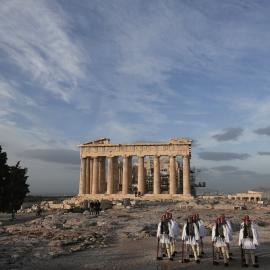James Cuno (“Culture War,” November/ December 2014) makes an unpersuasive argument against the repatriation of museum artifacts to their countries of origin. Certainly, as Cuno writes, encyclopedic museums broaden our understanding of the historical interplay among cultures. But he goes too far when he flatly dismisses countries’ claims to historical objects as “frivolous” and overly nationalist. He too easily brushes aside the moral case for returning objects to the countries in which they were first unearthed—and, in particular, he is too quick to dismiss Greece’s case for the repatriation of the Elgin Marbles.
Apparently with the permission of Greece’s indifferent Ottoman rulers, Thomas Bruce, seventh Earl of Elgin, acquired the marbles between 1801 and 1812, crudely hacking off the Parthenon’s sculptures and shipping them to the United Kingdom. Far from protecting the sculptures, however, the British Museum spent years systematically scraping and destroying their surfaces in an attempt to whiten them, only to belatedly realize its mistake and attempt to cover up the damage it had done.
Cuno scoffs at Athens’ insistence that returning the marbles would “restore the unity” of the Parthenon. But of course it would. Unlike the churches and mosques that foreign powers built on the Acropolis, which were subsequently removed by the newly independent Greek government, the marbles are physically integral to the Parthenon itself. Illuminating ancient Athenian values and stories, they breathe life into one of the world’s greatest architectural achievements. Visible to the people of Athens in their natural setting for more than two millennia, the marbles now find themselves 1,500 miles away from home, stuck in a dim, cavernous room in the British Museum, starved of context. Greece’s calls for their return are no less frivolous than the United Kingdom’s would be had half of Stonehenge been carted away by foreign thieves.
The Elgin Marbles controversy is a sorry testament to the paternalist arrogance of the British government, which continues to claim that these sculptures are better maintained, displayed, and studied in the British Museum than they would be in the state-of-the-art Acropolis Museum, a stone’s throw from the Parthenon.
